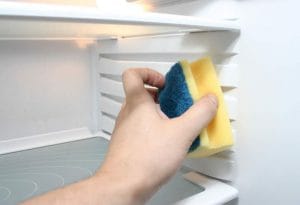Give your fridge room to breathe
 Fridges function best with a little space. Allow at least a 1cm gap on the left and right, and 2cm behind, and don’t stack anything on top of it. If your fridge is in direct sunlight, install a window blind to screen out the worst of the sun. If the fridge itself is hot, it will need to work harder to keep the food inside cool. Better still, ventilate the fridge space to the roof void or through outside walls.
Fridges function best with a little space. Allow at least a 1cm gap on the left and right, and 2cm behind, and don’t stack anything on top of it. If your fridge is in direct sunlight, install a window blind to screen out the worst of the sun. If the fridge itself is hot, it will need to work harder to keep the food inside cool. Better still, ventilate the fridge space to the roof void or through outside walls.
Clean from the top down
Every four to six months, clean the inside and outside of both fridge and freezer. Clean one shelf at a time, from top to bottom so that if you dribble crumbs, sauce or even detergent, you’re not dirtying shelves you’ve already cleaned. Wipe the interior with a solution of mild detergent or bicarb soda. If the shelves are removable, clean them in the sink with warm water and mild detergent, but let glass shelves come up to room temperature before plunging them into hot water so that they don’t crack. Dry them thoroughly before you put them back. Make sure the drain hole at the base of the fridge is clear and finish by wiping the rubber door seals with the mild detergent solution, taking care to clear all dirt from within the grooves.
Freshen a smelly fridge
Halve a lemon and scoop out the flesh. Fill your empty lemon shell with salt and pop it in a back corner of the fridge for a cheap but effective natural deodoriser.
Defrost freezers to keep them cool.
Unless your freezer is a frost-free model, with an automatic defrost system, defrost it every six months. A build-up of frost will reduce the freezer’s efficiency and can cause the cooling system to fail. Wrap any frozen food in newspaper or blankets and put it somewhere cool while you work – a cold or, better still, snowy day is perfect for this job, as you can put the food outside to stay frozen. Turn the thermostat to Off or Defrost, unplug the freezer and carefully scrape away ice with a blunt plastic tool. Once the frost has all been removed, wipe the inside of the freezer with a bicarb soda solution, wash any removable doors or drawers and allow everything to dry before resetting the thermostat, switching the freezer back on and refilling it.
Vacuum dust from the coils.
Your refrigerator’s coils are notorious dust catchers, but they’re simple to clean. Pull out the fridge to reach the back, unplug it for safety and use the hose and nozzle or soft brush attachment of your vacuum cleaner to clean dust and dirt from the grid of wire-like coolant pipes and around the motor. Clean the coils every three months, or more often if you have pets. Dirt and dust can inhibit the dissipation of heat, causing the unit to run poorly, cycle on and off too often, or not run at all.
Put your fridge on the level.
A refrigerator is most efficient when it’s level. Look for the unit’s feet or castors (right) and raise or lower them with an adjustable wrench or by turning their leveling screws with a screwdriver. On some refrigerators, you may have to remove the toe plate to gain access. Use a spirit level to make sure the fridge is balanced.
Give door seals the paper test
If the door doesn’t seal tightly, your food will spoil more quickly and your energy bill will skyrocket.Twice a year, put a sheet of paper between the door and the refrigerator unit and close the door, then try to pull the paper out (do this in several places around the door). If there’s no resistance, the seal isn’t working. If the seal appears stiff or cracked, replace it; if it looks good, lightly coat the flat surface with petroleum jelly to keep it from sticking.
Easy fixes- Fixing a saggy door
A level fridge is an efficient fridge. Most doors can only take a maximum of 6 kilos (equivalent to 6 litres) of weight. If your door seal is in good condition but still not sealing properly, the door may be warped or sagging. To fix it, take everything off the door shelves, loosen the screws behind the door seal or on the plate on top of the door, then grasp the door and flex it until it closes flush with the refrigerator. Tighten the screws to hold the door in place.
This is easier to do with a helper.

